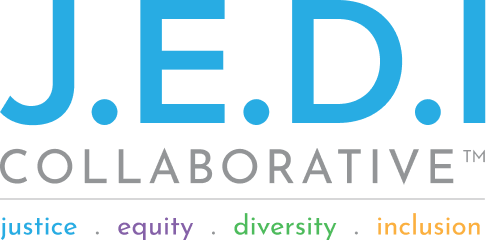Regardless of the size, structure and culture of your company, there are some basic steps to take to successfully embed justice, equity, diversity and inclusion (J.E.D.I) principles into the fabric of a company. Below are guiding steps that allow you and your team to create the J.E.D.I path that works best for you.
The Flow of Your J.E.D.I Journey
Get your CEO/leadership engaged
Research shows that without the buy in of senior leadership, J.E.D.I work will have considerably less likelihood of long-term success. While all people in your company should be contributing to incorporating J.E.D.I principles, those who manage the budgets, sign off on strategic direction, and make big decisions need to be bought into its importance.
Make sure you have basic infrastructure in your company to support J.E.D.I work
For the work to be sustainable, your company needs strong infrastructure. This includes a culture of transparency and openness, ways to gather input from your constituents (customers, suppliers, vendors, and distributors), ability to track staff demographic data accurately and ethically, resources for continuing education, and (for larger companies with an HR department) a person dedicated to people and culture (and not just compliance). To guide the work, you should create a cross-company committee or task force consisting of employees across hierarchies and identities who can candidly participate in open dialogue.
Get a basic understanding of the “what” and “why” of J.E.D.I
All employees need to have a basic understanding of what J.E.D.I means and why it is important to your company and its mission; you can deliver this information to employees through workshops, webinars, or during on-boarding for new employees.
Craft your J.E.D.I statement
Leadership and key influencers within your company should collaboratively craft a J.E.D.I statement to articulate how your company specifically can contribute to a more equitable and just world. This serves as a guiding document to give staff clear guidance and communicate to customers, community partners, suppliers, distributors, and the public what they can expect from you. There are many diverse and great examples of statements.
Identify your commitments
We focus on three main commitment areas: Culture, Consumer and Communities. Within each commitment area you’ll find examples of specific J.E.D.I commitments you can make, along with action steps to bring those commitments to fruition. To ensure your commitments are holistic, we suggest selecting at least one commitment from each of the three focus areas.
Create J.E.D.I KPIs
Create KPIs (key performance indicators) for your J.E.D.I commitments. Consider how to incorporate your commitment KPIs into your organizational and individual performance reviews.
Get help with specific tactics from those who know
As you get more clear about your own J.E.D.I work, seek out solutions partners to support discrete portions of your work. Take advantage of J.E.D.I resources - webinars, events, articles, books, case studies and more!
Inspire and engage your whole team
Be sure to celebrate progress along the way, encourage learning, and continue to remind employees why J.E.D.I is so important. Remind employees how J.E.D.I commitments will be reflected in their individual performance reviews.
Be flexible
Though goals and plans are necessary to do J.E.D.I work, you need some flexibility to change course as new needs arise. You will most likely need to re-evaluate and tweak your plan as you gain more knowledge or perhaps as your team shares new brilliant ideas. Be nimble enough to be able to learn from mistakes and support individuals or department wide J.E.D.I related innovation.
Some considerations while
identifying commitments:
- Engage staff when identifying commitments; the more staff you involve in identifying commitments, the more likely they are to be successful.
- Create goals and key performance indicators (KPIs) to measure success. KPIs will be quantitative and qualitative depending on the commitment and what is being measured.
- Remember the work is iterative rather than linear; there are many right places to start this work. Don’t let not knowing where to start hinder you from starting at all.
- Do not let lack of knowledge or skills hinder your J.E.D.I efforts; remember that you will be learning in this journey and may need outside help. Budget your time and money for that.
- It is vital to create a culture of inclusivity, belonging and openness. People need to feel safe for this to work. Due to the nature of the work, this culture is critical for the work to build, thrive and stick.
- This work can feel messy and personal. Everyone will make mistakes. The key is a supportive environment that allows space for hard conversations without judgement attached.
- Be in it for the long haul – know that you cannot do everything all at once and that the work will never end. This is about continuous progress vs. perfection.
- Be sure that your commitments are in line with your J.E.D.I statement
Ready to get started?
J.E.D.I Commitments are categorized under three focus areas:



